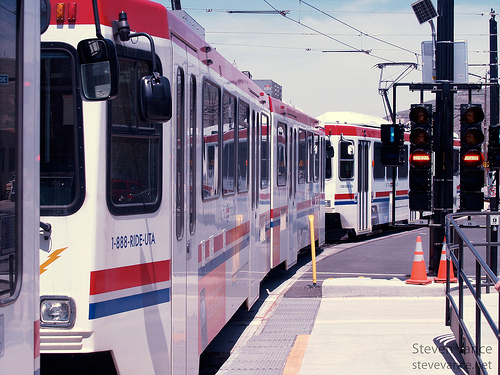Salt Lake City angles for mass transit upgrades
Salt Lake City commuters may eventually enjoy faster buses and trains, fewer transfers, and cleaner air. But “may” is the keyword — the Salt Lake City Council has asked for a Transit Master Plan to promote “a future of clean air, economic development and a lifestyle independent of cars,” according to The Salt Lake City Tribune. But the state’s Utah Transit Authority is ultimately responsible for the plan, and that bureau isn’t required to execute any changes.

A stop on Salt Lake City’s successful – and exapanding – TRAX light rail system. From Steven Vance.
The City in tandem with the Utah Transit Authority will pay for a study that, according to the Tribune, “will lead” to the Transit Master Plan and its promised changes, such as fewer transfers and more commuting options. The changes won’t be immediate. As Council Chairman Kyle LaMalfa told UTA officials, “We know it won’t happen tomorrow.”
Salt Lake City commuters do have hope, however. The state and the city are putting their money where their promises are: The commissioned study is costing the municipality $150,000 and UTA the remaining $200,000. “The study should bring UTA and Salt Lake City closer together,” LaMalfa said, according to the Tribune. He mentioned that the UTA has been “responsive” to the city’s mass transit interests.
The city and the transit agency have already collaborated on the new mass transit pass, which will cost $360 and become available to SLC residents starting in January, and a new streetcar that opened in early December.
However, another transit study in the area has proven to be divisive at best, and futile at worst. One $150,000 study, which was lobbied for by the city mayor and supported by a council majority, identified a particular area in the city as best for extending a streetcar line. Yet the study was met with lacking public support and, reports the newspaper, “remains controversial.”
Several politicians have said that collaboration between the city and the UTA is necessary to the project’s success. Councilman Charlie Luke said, “It makes sense to involve UTA early on in the master-plan process. This is our opportunity to let them know what it is we need in Salt Lake City for our residents.” Councilman Luke Garrott maintained that the study’s focus must be defined before hiring consultants to carry it out, and that the city council’s goals, including more commuting alternatives and faster buses and trains, must be included in the study proposal.
City transportation director Robin Hutcheson explained in a statement, “The study includes assessing demand for different types of transit, examining corridors and nodes where additional transit would be suitable and also will include strategies to improve convenience and comfort.”
Certain areas of the city stand to benefit perhaps more than others. The UTA has installed 70 miles of rail line within the last seven years. Although, generally, the light rail has been successful, service in certain neighborhoods is sub-standard. “If we really want to create a lifestyle change, we’re going to have to change routes and make them usable,” said Councilman Luke. “We don’t have a usable system for all residents now.”
The study will commence in early 2014.
Category: Infrastructure, Trends


















